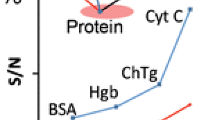Abstract
Liquid chromatography coupled online to nano-electrospray ionization (nESI) tandem mass spectrometry is the analytical workhorse in the field of proteome research. Dimethyl sulfoxide (DMSO) was recently shown to improve nESI efficiency by a factor of three to ten thus improving the sensitivity and coverage of proteomic experiments. However, relatively few investigations into which solvent additives promote nESI response have been performed at a proteomic scale. Here, we systematically evaluated the concept by screening about 30 compounds with various physico-chemical properties. Detailed further analysis showed that ethylene glycol performed similarly to DMSO and the results indicate that enhancing the nESI response of peptides by simple solvent additives is a valid and promising approach. Ethylene glycol may serve as a viable alternative to DMSO in applications where DMSO has disadvantages. In keeping with nESI theory, the key properties of an effective solvent additive for proteomic applications are a boiling point higher than water, low surface tension, and preferably high polarity for reversed phase LC-MS/MS applications.

Ethylene glycol substantially improves peptide ionization




Similar content being viewed by others
References
Yamashita M, Fenn JB. Electrospray ion source. Another variation on the free-jet theme. J Phys Chem. 1984;88(20):4451–9.
Whitehouse CM, Dreyer RN, Yamashita M, Fenn JB. Electrospray interface for liquid chromatographs and mass spectrometers. Anal Chem. 1985;57(3):675–9.
Fenn JB. Ion formation from charged droplets: roles of geometry, energy, and time. J Am Soc Mass Spectrom. 1993;4(7):524–35.
Wilm MS, Mann M. Electrospray and Taylor-Cone theory, Dole’s beam of macromolecules at last? Int J Mass Spectrom Ion Process. 1994;136(2):167–80.
Wilm M, Mann M. Analytical properties of the nanoelectrospray ion source. Anal Chem. 1996;68(1):1–8.
Cox JT, Marginean I, Smith RD, Tang K. On the ionization and ion transmission efficiencies of different ESI-MS interfaces. J Am Soc Mass Spectrom. 2014;1–8.
Krutchinsky AN, Padovan JC, Cohen H, Chait BT. Optimizing electrospray interfaces using slowly diverging Conical Duct (ConDuct) electrodes. J Am Soc Mass Spectrom. 2015;26(4):659–67.
Krutchinsky AN, Padovan JC, Cohen H, Chait BT. Maximizing ion transmission from atmospheric pressure into the vacuum of mass spectrometers with a novel electrospray interface. J Am Soc Mass Spectrom. 2015;26(4):649–58.
Kelly RT, Tolmachev AV, Page JS, Tang K, Smith RD. The ion funnel: theory, implementations, and applications. Mass Spectrom Rev. 2010;29(2):294–312.
Giles K, Pringle SD, Worthington KR, Little D, Wildgoose JL, Bateman RH. Applications of a travelling wave‐based radio‐frequency‐only stacked ring ion guide. Rapid Commun Mass Spectrom. 2004;18(20):2401–14.
Nugent K, Kent P, Upton L. Journal of biomolecular techniquesP32-M HT proteomics LC/MS for analysis of low-abundance proteins, PTMs, and biomarkers. J Biomol Tech. 2007;18(1):12.
Page JS, Tang K, Kelly RT, Smith RD. Subambient pressure ionization with nanoelectrospray source and interface for improved sensitivity in mass spectrometry. Anal Chem. 2008;80(5):1800–5.
Szabó PT, Kele Z. Electrospray mass spectrometry of hydrophobic compounds using dimethyl sulfoxide and dimethylformamide as solvents. Rapid Commun Mass Spectrom. 2001;15(24):2415–9.
Cole R, Harrata AK. Solvent effect on analyte charge state, signal intensity, and stability in negative ion electrospray mass spectrometry; implications for the mechanism of negative ion formation. J Am Soc Mass Spectrom. 1993;4(7):546–56. doi:10.1016/1044-0305(93)85016-Q.
Ogorzalek Loo RR, Lakshmanan R, Loo JA. What protein charging (and supercharging) reveal about the mechanism of electrospray ionization. J Am Soc Mass Spectrom. 2014;25(10):1675–93. doi:10.1007/s13361-014-0965-1.
Hahne H, Pachl F, Ruprecht B, Maier SK, Klaeger S, Helm D, et al. DMSO enhances electrospray response, boosting sensitivity of proteomic experiments. Nat Methods. 2013;10(10):989–91. doi:10.1038/nmeth.2610.
Meyer JG, Komives EA. Charge state coalescence during electrospray ionization improves peptide identification by tandem mass spectrometry. J Am Soc Mass Spectrom. 2012;23(8):1390–9. doi:10.1007/s13361-012-0404-0.
Richards AL, Hebert AS, Ulbrich A, Bailey DJ, Coughlin EE, Westphall MS, et al. One-hour proteome analysis in yeast. Nat Protoc. 2015;10(5):701–14.
Rosting C, Gjelstad A, Halvorsen TG. Water-soluble dried blood spot in protein analysis: a proof-of-concept study. Anal Chem. 2015;87(15):7918–24.
Distler U, Kuharev J, Navarro P, Tenzer S. Label-free quantification in ion mobility-enhanced data-independent acquisition proteomics. Nat Protoc. 2016;11(4):795–812.
Ruprecht B, Koch H, Medard G, Mundt M, Kuster B, Lemeer S. Comprehensive and reproducible phosphopeptide enrichment using iron immobilized metal ion affinity chromatography (Fe-IMAC) columns. Mol Cell Proteomics. 2015;14(1):205–15. doi:10.1074/mcp.M114.043109.
Lide DR. CRC handbook of chemistry and physics. Boca Raton: CRC Press; 2004.
Yaws CL, Richmond PC. Chapter 21—Surface tension—organic compounds. Thermophysical properties of chemicals and hydrocarbons. Norwich: William Andrew Publishing; 2009. p. 686–781.
Hunter EP, Lias SG. Evaluated gas phase basicities and proton affinities of molecules: an update. J Phys Chem Ref Data. 1998;27(3):413–656.
Chambers MC, Maclean B, Burke R, Amodei D, Ruderman DL, Neumann S, et al. A cross-platform toolkit for mass spectrometry and proteomics. Nat Biotechnol. 2012;30(10):918–20.
Valot B, Langella O, Nano E, Zivy M. MassChroQ: a versatile tool for mass spectrometry quantification. Proteomics. 2011;11(17):3572–7.
Vizcaíno JA, Côté RG, Csordas A, Dianes JA, Fabregat A, Foster JM, et al. The PRoteomics IDEntifications (PRIDE) database and associated tools: status in 2013. Nucleic Acids Res. 2013;41(D1):D1063–9.
Šamalikova M, Grandori R. Protein charge-state distributions in electrospray-ionization mass spectrometry do not appear to be limited by the surface tension of the solvent. J Am Chem Soc. 2003;125(44):13352–3. doi:10.1021/ja037000u.
Acknowledgments
We gratefully acknowledge the funding from TUM University Foundation, Alexander von Humboldt Foundation, and Carl Friedrich von Siemens Foundation (to P.Y.). This work was also in part funded by the German Federal Ministry for Education and Research (grant 031L0008A). The authors also wish to thank Andreas Klaus for technical assistance, Chen Meng for help with data processing, and many of the current and former members of the laboratory for help with experiments and general discussion.
Author information
Authors and Affiliations
Corresponding author
Ethics declarations
Conflict of interest
The authors declare that they have no conflict of interest.
Electronic supplementary material
Below is the link to the electronic supplementary material.
ESM 1
(PDF 785 kb)
Rights and permissions
About this article
Cite this article
Yu, P., Hahne, H., Wilhelm, M. et al. Ethylene glycol improves electrospray ionization efficiency in bottom-up proteomics. Anal Bioanal Chem 409, 1049–1057 (2017). https://doi.org/10.1007/s00216-016-0023-x
Received:
Revised:
Accepted:
Published:
Issue Date:
DOI: https://doi.org/10.1007/s00216-016-0023-x




